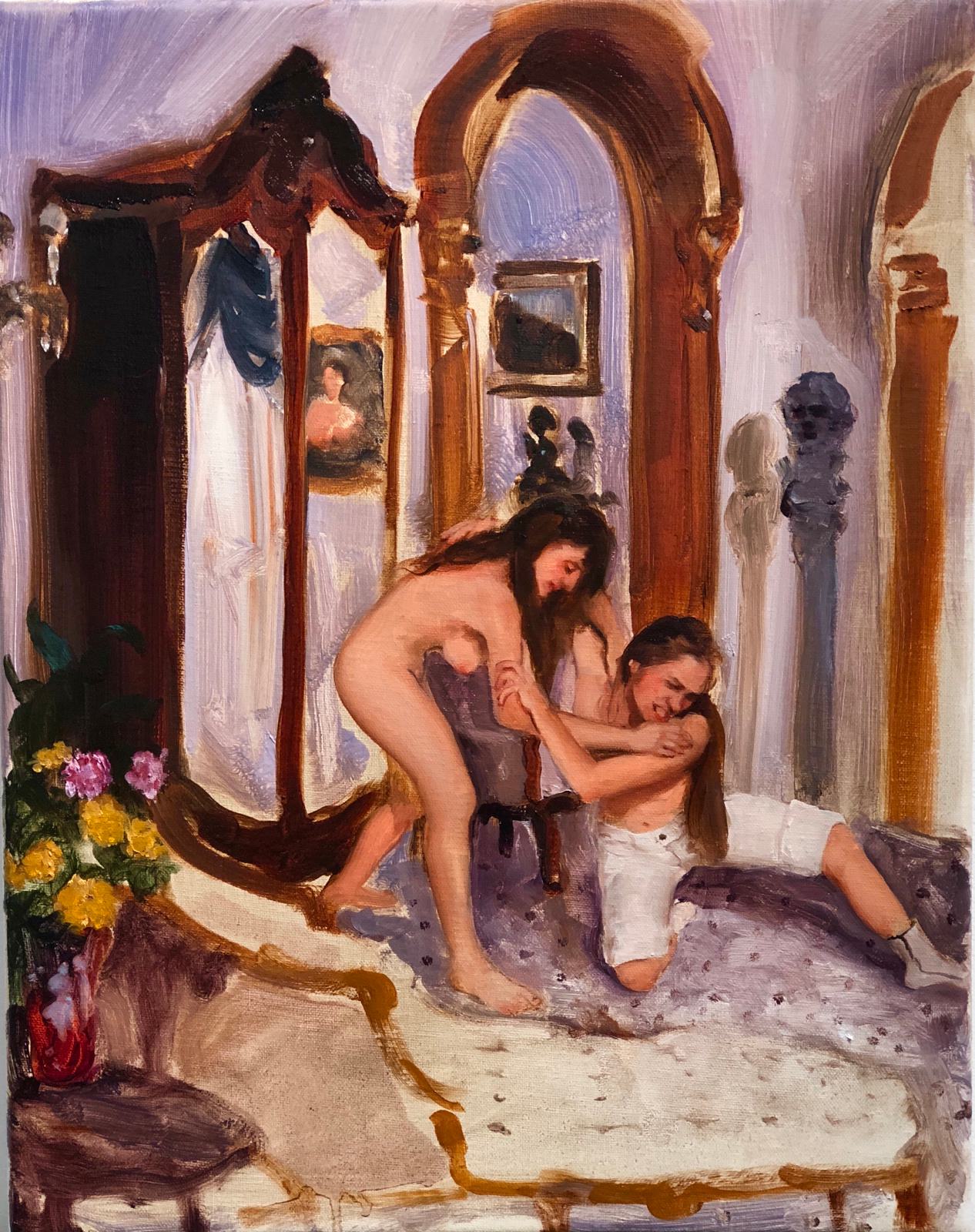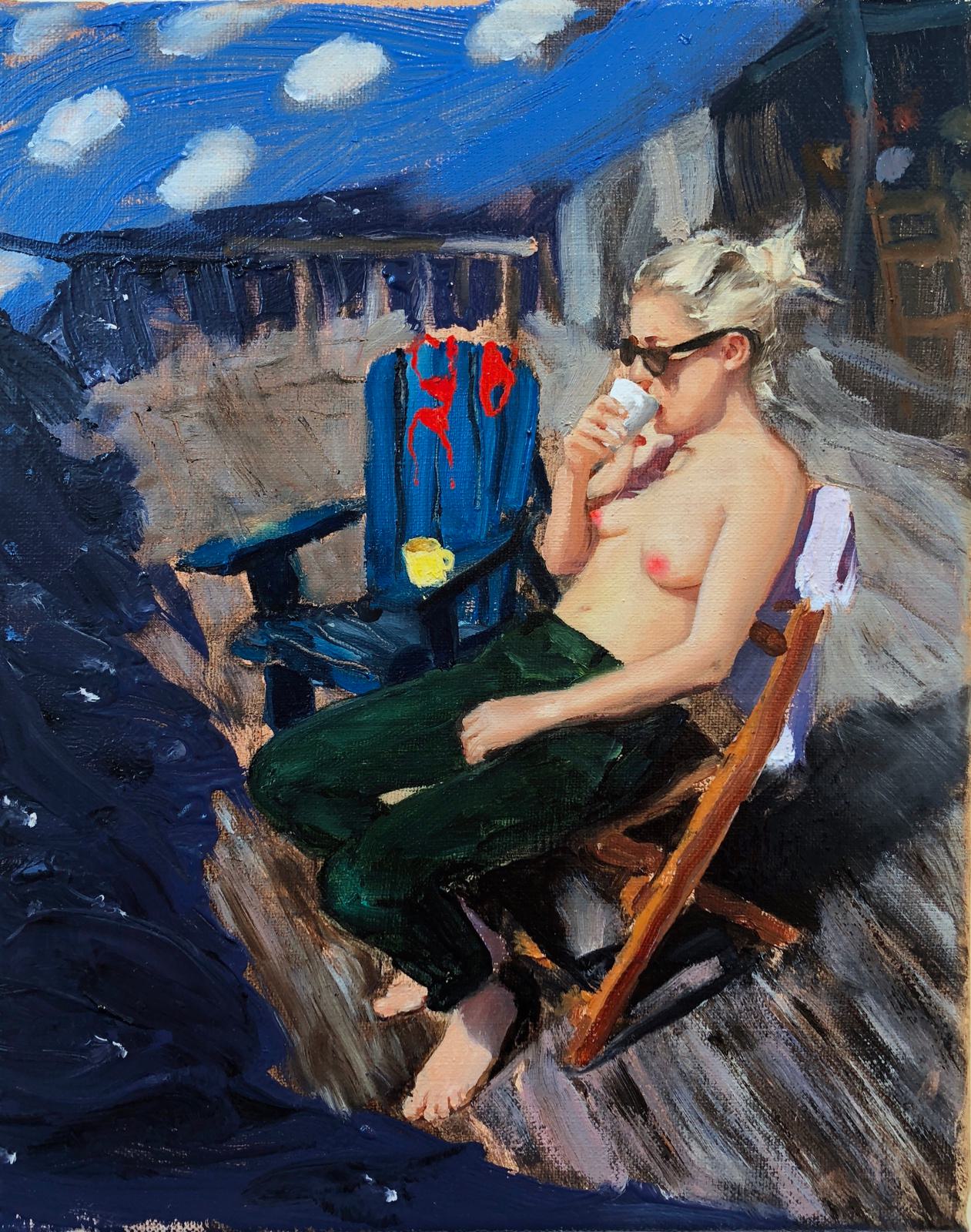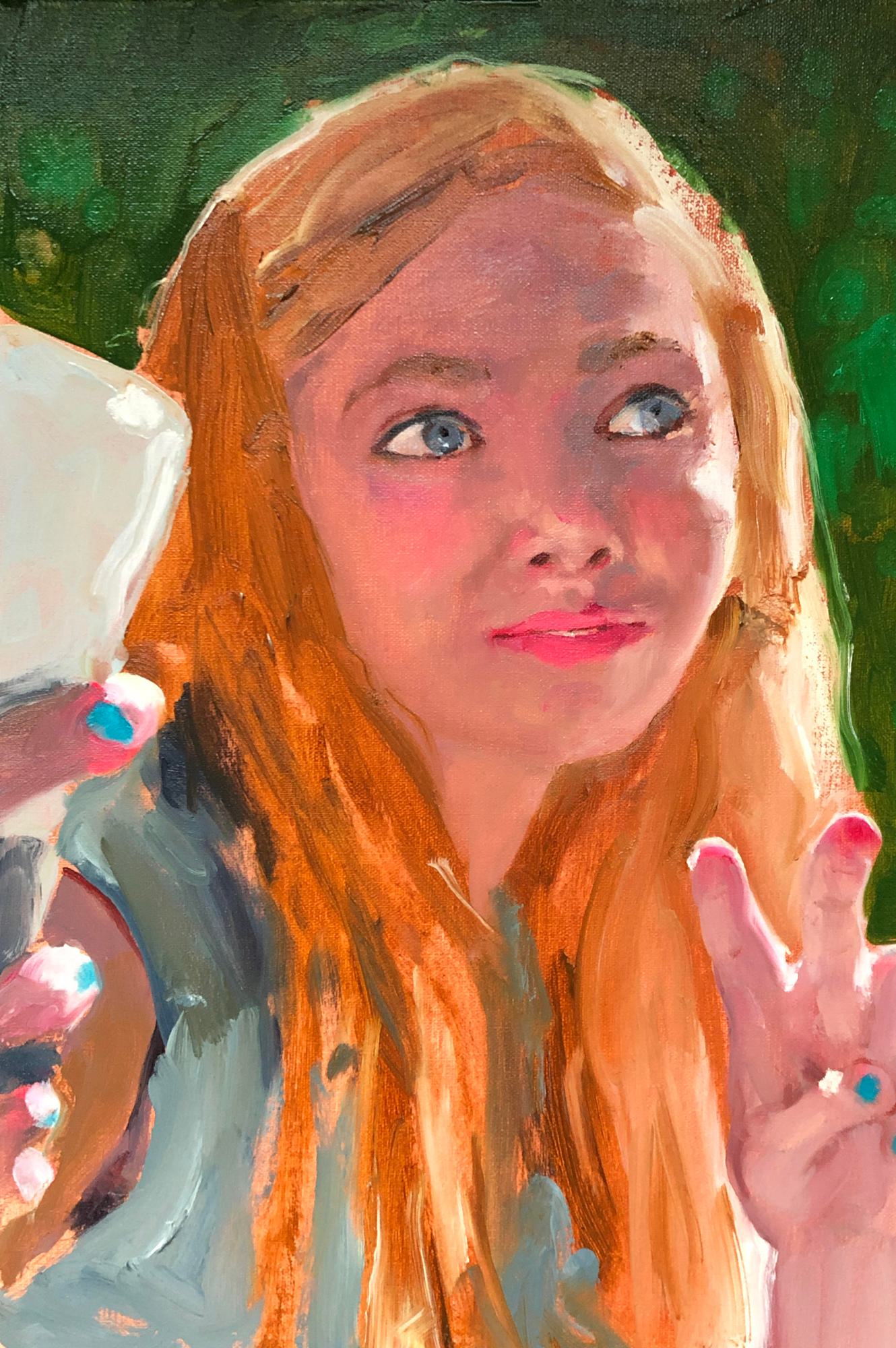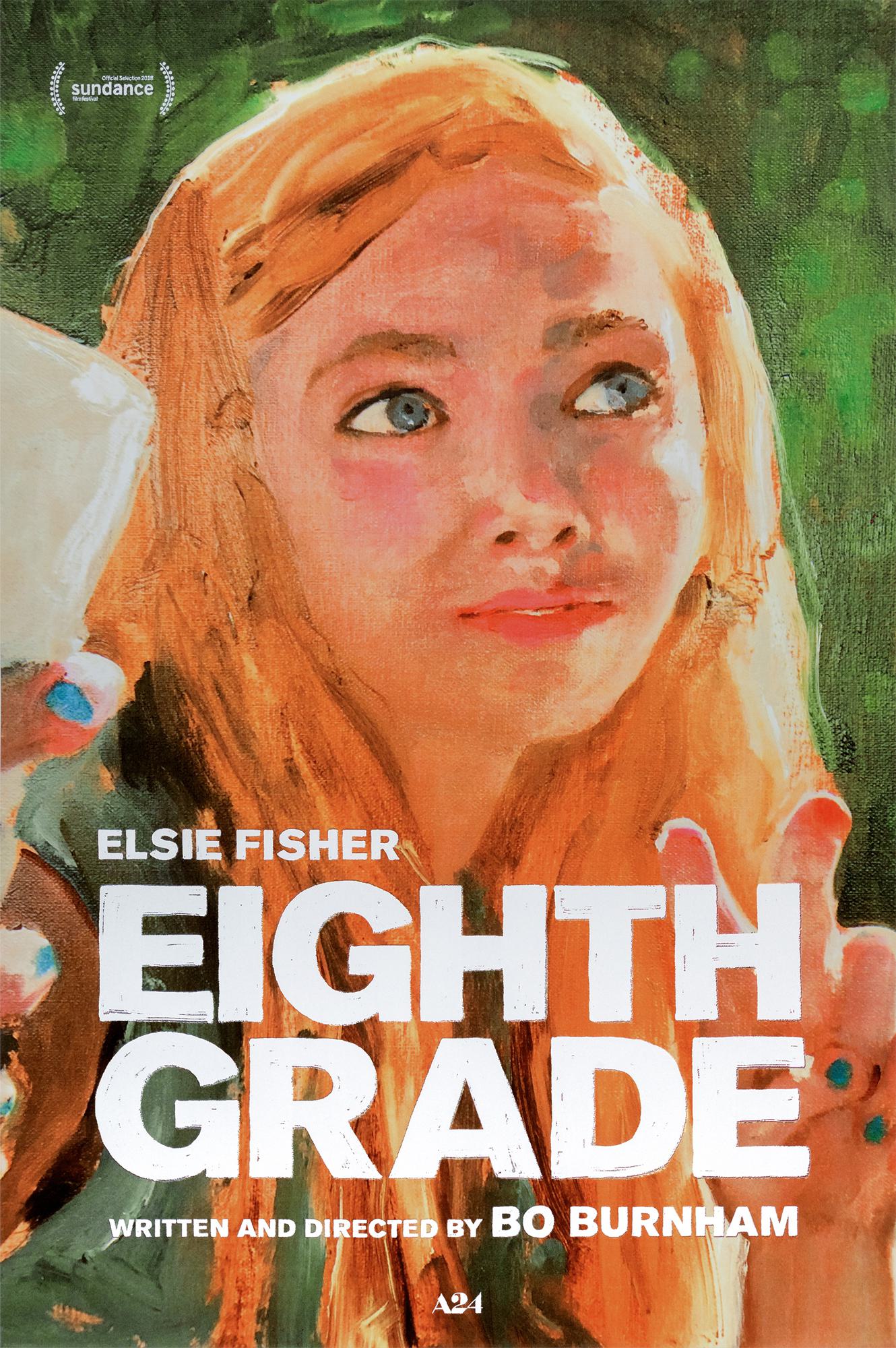By Christine Smallwood
When A24 asked painter Jenna Gribbon to make a poster for Bo Burnham’s Eighth Grade, she chose a still that features actress Elsie Fisher with eyes looking up and to the side, while her left hand flashes a weak peace sign.
Gribbon cropped the image close and made the colors deeper and more vivid. In her version, Fisher’s cheeks are rosy, her lips are fluorescent and smudged, and her hair is the warm gold of a Botticelli. She holds a white rectangle in one hand, but because Gribbon did not paint in the Apple logo, it may take a moment to realize that the character is engaged in the twenty-first century rite of looking hopefully to the heavens and posing for a selfie.
Gribbon’s lush and evocative oil paintings foreground vulnerability with a sense of humor that can be sweet or a little campy. Some of her subjects seem to be caught in moments unaware that they are being watched, while others look boldly at the viewer. In both cases she paints with fluid texture, and the people she paints are at ease with themselves. They may be topless or sexualized, but there is never a sense of shame; if they are naked, they are not really exposed.
I met Gribbon at the humongous live-work space in Bushwick where she and her girlfriend Mackenzie, who is featured in many of her paintings, were staying. She was preparing for a solo show in September at Fredericks & Freiser in Chelsea. On one wall of the studio hung a row of small paintings based on real moments or photographs that had been distorted. “Memories aren’t fixed things,” she said. There were also larger scenes of women and girls wrestling in different scenarios, such as Ballet Class Wrestlers and Picking Blackberries by the Side of the Road Wrestlers. For those, Gribbon takes a childhood or adolescent memory of a place and stages friends wrestling there, at once sending up a classic painting trope and “superimposing the current self on...some way that you saw yourself in the past.”
Gribbon spoke admiringly of the “beautiful, pastoral light” in Eighth Grade. “My work uses that kind of light to contribute to the feeling of the experience of memory,” she said.


Do you ever paint outside?
I don’t, no. It’s too hard. There’s bugs and dirt and that kind of thing.
You usually paint adults. Was there anything different about painting an adolescent?
Well, I paint my child a lot also. A lot of my work has an erotic component and a sexual component. I paint those things, and I also paint my child, because it’s all under the umbrella of intimacy for me. I like driving home the point that it’s the same human being who is this sexual being and also a mother. It’s not a separate person, so why should those paintings not be able to sit on the wall at the same time together? There are all kinds of scenarios in our lives that create vulnerability in us. Eighth Grade does a good job of creating a narrative that allows adults, I think, to be able to remember the vulnerable adolescent experience.
What did the film make you remember about your own adolescence?
It’s so hard to put into words. My girlfriend and I tried to watch it together, and she could almost not handle it because it was so transportive. It really does take you back to that feeling, that moment in time. You’re really aware that you’re on the cusp of something and that you’re just sort of standing on the edge of a cliff. It’s so mysterious. It’s really exciting, but also scary, and [there's] also something kind of repulsive about it—you do and don’t want to leave childhood.
There’s so much technology in the movie, and it got me thinking about trying to talk to you about oil painting as a technology.
Your question reminds me of something that is a common concern of that film and my work, which is the experience of both looking and being looked at, and the constant feedback loop that we are in. Especially as a young woman, you’re constantly seeing yourself through the eyes of other people. I think that my work is a lot about the experience of being looked at, and also looking, and making people conscious of the way that we’ve consumed images of women in painting in the past. In adolescence it’s in a very heightened state, the sense of being seen through someone else’s eyes.
It’s as if [Kayla] thinks this selfie might be the one that will make everyone see her the way she wants to be seen.
The paintings over there are so beautiful. This color—the day-glo orange color on the nipples and the bathing suit. That’s just amazing.
I like the idea that there’s this light source and it comes out through the nipples. I think it’s funny. But the nipples, I always paint them in this fluorescent way. It speaks to the censorship of the nipple. It’s the opposite; I’m going to emphasize the nipple. And it’s also to create this uncomfortable tension with the viewer, where they’re super aware that they’re looking, and they know they’re not supposed to look there, but they can’t help it. Then it creates this feeling of, well, why am I uncomfortable, or why am I not supposed to look at that? And why should it be so easy to look at and consume a body? Maybe you should feel that uncomfortable tension. I want to create that experience for the viewer, so that they can be a little bit more aware that they’re consuming an image of the body.
For the poster, you chose a moment where the character is constructing how her image will be consumed—mediated by the phone, and assuming, hoping, to be looked at.
I do love how vulnerable and self-conscious she is in that still, but also hopeful. It’s as if she thinks this selfie might be the one that will make everyone see her the way she wants to be seen. My work is ultimately about looking and being looked at and creating a self-consciousness around those acts, so that image really resonated with me. It felt important to include the phone because the way she navigates her relationship to technology, and the versions of herself that are being reflected back to her through those tools, is such an important part of the film.
When we were talking about the fluorescent nipples, you talked about how you want viewers of your work to have to experience the tension that comes with consuming an image of a body. Which leads of course to the question of selfies…
I definitely remember the advent of the selfie and being squeamish about it at first. I came of age in the 90s, and the ethos surrounding the ways that were acceptable to represent yourself were very different then. I’ve come around to them though. We have so many centuries of images of women generated by men, and it's exciting to see women and girls showing us how they want to be seen. Their phones have put the power to do this literally in their hands, and there’s a lot of potential for this to be liberating. That said, it’s definitely disconcerting that young girls are subjected to such a magnified view of what other people think of their image at time when their own self concept is just forming. I think Eighth Grade speaks to these concerns with great sensitivity and intelligence.
Why didn’t you paint in the Apple logo, by the way?
I wanted the poster to advertise the film, not Apple.
What do you remember about eighth grade?
I remember the feeling of wanting to be an adult and feeling very grown up in so many ways, you know? It felt almost in my grasp. I didn’t really enjoy childhood. I was glad to leave it behind. But I didn’t have a terrible experience in eighth grade. Life got progressively better as I got older. Adolescence was better than childhood, and being a teenager was better than being an adolescent, and an adult was the best of all.
I was relieved that the movie didn’t allow anything really terrible to happen. She’s in a situation that feels scary, but it passes. And she uses all this technology, but the message is that she’s going to be okay.
Adolescence on its own is traumatic enough. It doesn’t really have to be that dramatized to feel terrifying.
This interview was edited and condensed for length and clarity.





